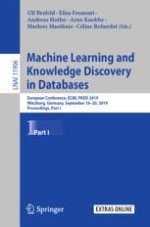The three volume proceedings LNAI 11906 – 11908 constitutes the refereed proceedings of the European Conference on Machine Learning and Knowledge Discovery in Databases, ECML PKDD 2019, held in Würzburg, Germany, in September 2019.
The total of 130 regular papers presented in these volumes was carefully reviewed and selected from 733 submissions; there are 10 papers in the demo track.
The contributions were organized in topical sections named as follows:
Part I: pattern mining; clustering, anomaly and outlier detection, and autoencoders; dimensionality reduction and feature selection; social networks and graphs; decision trees, interpretability, and causality; strings and streams; privacy and security; optimization.
Part II: supervised learning; multi-label learning; large-scale learning; deep learning; probabilistic models; natural language processing.
Part III: reinforcement learning and bandits; ranking; applied data science: computer vision and explanation; applied data science: healthcare; applied data science: e-commerce, finance, and advertising; applied data science: rich data; applied data science: applications; demo track.
Chapter "Heavy-tailed Kernels Reveal a Finer Cluster Structure in t-SNE Visualisations" is available open access under a Creative Commons Attribution 4.0 International License via link.springer.com.
